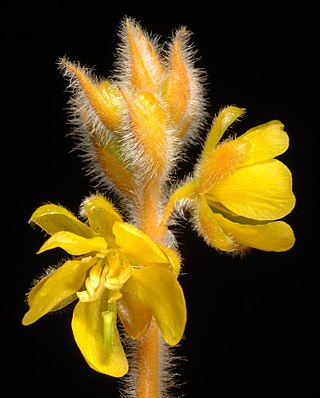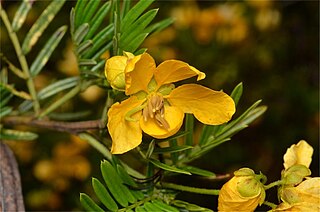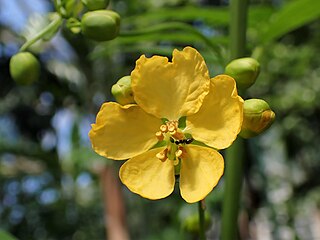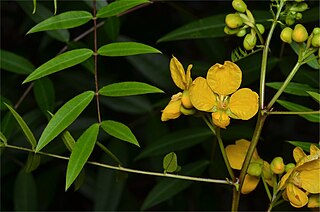
Senna gaudichaudii, also known by many common names, including kolomana in Hawaii and as blunt-leaved senna in Australia, is a species of flowering plant in the family Fabaceae and is native to some Pacific Islands including Hawaii, parts of Southeast Asia and Queensland in Australia. It is shrub or small tree with pinnate leaves, usually with three to five pairs of oblong to egg-shaped leaflets, and yellow flowers arranged in groups of four to ten, with ten fertile stamens in each flower.

Senna multiglandulosa, commonly known as glandular senna, downy senna, or buttercup bush is a species of flowering plant in the family Fabaceae and is native to Mexico, Guatemala, and western parts of South America. It is a shrub with pinnate leaves, usually with six to eight pairs of linear to lance-shaped leaflets, and yellow flowers arranged in groups of ten to twenty, with seven fertile stamens in each flower. It is widely cultivated as an ornamental plant and in some areas of the world has become naturalized.

Senna notabilis, commonly known as cockroach bush, is a species of flowering plant in the legume family Fabaceae, and is endemic to northern Australia. It is an erect, softly-hairy, annual or perennial shrub with pinnate leaves with six to twelve pairs of lance-shaped leaflets, and yellow flowers arranged in groups of twenty to thirty, with seven fertile stamens in each flower.

Senna aciphylla, commonly known as sprawling senna or Australian senna, is a species of flowering plant in the family Fabaceae and is endemic to eastern Australia. It is a sprawling shrub with pinnate leaves with eight to twelve pairs of linear to narrowly elliptic leaflets, and yellow flowers in pairs or groups of three.

Senna barclayana, commonly known as smooth senna or pepper-leaf senna, is a species of flowering plant in the family Fabaceae and is endemic to eastern Australia. It is a herbaceous perennial or subshrub with pinnate leaves with six to ten pairs of lance-shaped or narrowly elliptic leaflets, and yellow flowers in groups of six to ten.

Senna barronfieldii, commonly known as southern cassia, is a species of flowering plant in the family Fabaceae and is endemic to eastern Australia. It is an erect shrub with more or less glabrous, pinnate leaves with eight to thirteen pairs of lance-shaped or elliptic leaflets, and yellow flowers in groups of three to five.

Senna cardiosperma is a species of flowering plant in the family Fabaceae and is endemic to the western half of Australia. It is an erect shrub or small tree with pinnate leaves, the number and shape of the leaflets depending on subspecies, yellow flowers with ten fertile stamens in each flower, and flat pods.

Senna clavigera, commonly known as pepper leaf senna, is a species of flowering plant in the family Fabaceae and is endemic to eastern Australia. It is a perennial herb with pinnate leaves with four to seven pairs of lance-shaped to elliptic leaflets, and groups of four to twenty yellow flowers in upper leaf axils.

Senna costata is a species of flowering plant in the family Fabaceae and is endemic to northern Australia. It is a shrub or small tree with pinnate leaves with four or five pairs of narrowly elliptic leaflets, and yellow flowers arranged in pairs or groups of five to eight, with ten fertile stamens in each flower.
Senna ferraria is a species of flowering plant in the family Fabaceae and is endemic to north-western Western Australia. It is an erect shrub with pinnate leaves with three to four pairs of broadly elliptic to egg-shaped leaflets, and yellow flowers arranged in groups of about twelve, with ten fertile stamens in each flower.

Senna glutinosa is a species of flowering plant in the family Fabaceae and is endemic to central and northern arid areas of Australia. It is a shrub or small tree with pinnate leaves with up to seven pairs of leaflets, their shape depending on subspecies, and yellow flowers arranged in groups with ten fertile stamens in each flower.
Senna goniodes is a species of flowering plant in the family Fabaceae and is endemic to the far north of Western Australia. It is an erect, slender shrub with pinnate leaves with two or three pairs of narrowly elliptic to elliptic leaflets, and yellow flowers arranged in groups with ten fertile stamens in each flower.
Senna hamersleyensis, commonly known as creeping senna, is a species of flowering plant in the family Fabaceae and is endemic to the north of Western Australia. It is an erect, spreading or prostrate shrub with pinnate leaves with two to four pairs of broadly elliptic to egg-shaped leaflets, and yellow flowers arranged in groups of four or five, with ten fertile stamens in each flower.

Senna hirsuta, commonly known as woolly senna, is a species of flowering plant in the family Fabaceae and is native to Central and South America, but is naturalised in many other countries. It is an erect or spreading shrub or herbaceous perennial with pinnate leaves, with two to six pairs of egg-shaped leaflets, and yellow flowers arranged in groups of two to six, with six fertile stamens and four staminodes in each flower.
Senna leptoclada is a species of flowering plant in the family Fabaceae and is endemic to Arnhem Land in northern Australia. It is a glaucous, erect to drooping shrub with pinnate leaves usually with two pairs of broadly elliptic leaflets, and yellow flowers arranged in groups of two or three, with ten fertile stamens in each flower.

Senna magnifolia is a species of flowering plant in the family Fabaceae and is endemic to northern Australia. It is an erect, spreading or straggling, mostly glabrous shrub with pinnate leaves with four to six pairs of broadly oblong to round leaflets, and yellow flowers arranged in groups of twenty to sixty, with seven fertile stamens in each flower.

Senna oligoclada is a species of flowering plant in the family Fabaceae and is endemic to northern Australia. It is an erect shrub with pinnate leaves with one to three pairs of elliptic to egg-shaped leaflets, and yellow flowers arranged in groups of three to five with ten fertile stamens in each flower.

Senna planitiicola, commonly known as yellow pea, arsenic bush, ant bush or pepper-leaf senna, is a species of flowering plant in the family Fabaceae and is endemic to northern Australia. It is an erect shrub with pinnate leaves with five to seven pairs of broadly elliptic to egg-shaped leaflets, and groups of three to eight yellow flowers on the ends of branches and in upper leaf axils.

Senna pleurocarpa, commonly known as fire bush or chocolate bush, is a species of flowering plant in the family Fabaceae and is endemic to Australia. It is a spreading shrub with pinnate leaves with five to seven pairs of broadly elliptic to egg-shaped leaflets, and groups of five to twelve yellow flowers arranged in dense groups of twenty to sixty on the ends of branches and in upper leaf axils.
Senna sericea is a species of flowering plant in the family Fabaceae and is endemic to inland north-western Australia. It is an erect shrub with pinnate leaves, with one or two pairs of egg-shaped leaflets, and yellow flowers arranged in groups of four to twelve, with ten fertile stamens in each flower.















